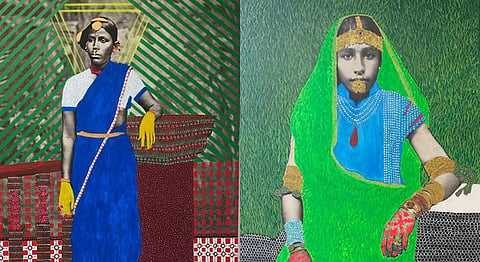
- HOMEGROWN WORLD
- #HGCREATORS
- #HGEXPLORE
- #HGVOICES
- #HGSHOP
- CAREERS
- ABOUT US
- CONTACT US

For a very long time, the voices of women were subdued and relegated to the subaltern – the peripheries of history, a subject otherwise wholly dominated by masculinist narratives. Feminist historians have found that most of the properly-documented ‘history’ has either erased or modified women’s roles and stories, and, therefore, uncovering these alternative histories has been a task of picking from crevices and digging from underneath seemingly impenetrable strata of debris.
The same is true of the visual documentation and one of the major instances of this silencing can be seen in the case of indentured Indian women in the British colonies of the Caribbean, where many photographers participated in a postcard industry that portrayed these women as ‘Coolie Belles’ – ‘coolie’ being a derogatory term for ‘labourer’. It was a thriving industry that men made money from.
Black and white portraits of these ‘Coolie Bellies’ by French photographer Morin that served to advertise these women as exotic Asian beauties are specifically important to this documentation. The monochromatic façade of portraiture reduced these women to nothing more than objects. It rendered them helpless and subjected them to the patronising gaze of the hedonistic onlooker, as a site of fetish and control. This phenomenon robbed women of their agency to gaze back or revolt during a system of indentureship in colonial Trinidad which saw high rates of gender-based violence.
Renluka Maharaj, a second-generation Indo-Caribbean woman born in present-day Trinidad came across Morin’s photography while conducting research on her own family’s history. She wonders whether these women were photographed of their own accord or even compensated for it. In a way, she feels that their images were manipulated to create a ‘brand’ of what an Indian woman should look like, in order to lure western tourists to the island. So, she strives to gauge the extent to which these women participated or didn’t participate in the branding in order to point out the gaping loopholes in mainstream historiography.
Further, she also feels that Morin’s photographs reeked of the legacy of a certain kind of western aesthetic which put monochrome photography on a pedestal. She believes that even though as an artist, one might feel obligated to eulogise this kind of aesthetic, she doesn’t subscribe to it unless a specific project demands it.
Moreover, as an artist and painter herself, she has had a rather intimate exposure to colours her entire life. From brightly-coloured decorations to colourful deities on shrines, bright colours were pretty much ubiquitous in her home. So, when she came upon these black-and-white pictures of indentured women, she took the opportunity to resuscitate them with a dash of colour as a means to ‘uplift these women out of the colonial archives’ as well as ‘reimagine and re-present them’ in a light that she felt would be more reverent. She aimed to represent them not as victims or objects, but as ‘women we know, women with agency, choices, strength, beauty and power’. This is done not in any way to negate their violent history, but to situate their existence outside the colonial gaze, thereby seeing them as sisters, wives, daughters and lovers, and moreover, as independent beings with their own agency and individuality. An exercise in foregrounding the selfhood of these women, Maharaj’s photographs embellish Morin’s original photographs in a mixed-medium of acrylic paint, glitter and rhinestones, making their faces stark and conspicuous.
Maharaj’s maternal grandparents arrived at Trinidad as indentured labourers under the British in 1913. She has ten siblings, most of whom live in New York City and Trinidad at present. For a long time, she felt out of place within the Indian communities in New York City, since she didn’t hail directly from India. However, when she finally found her Indo-Caribbean community years later, she felt seen for the first time outside her family. Even though being connected to indentureship is now an accepted part of her history, she feels that there’s still a lot more work to be done and questions to be answered about it. Her work chiefly resides around this, and her quest for her family’s identity and history, and in turn, her own.
Check out her art works here.
If you enjoyed reading this article, we suggest you also read:
